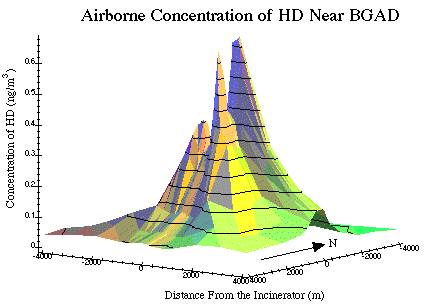Primary Goal of the Research–
To Provide Answers to Mathematical Questions Posed by KEF
- Model the dispersion of particulates of incomplete combustion, particularly dioxins, in the area near the proposed incinerator.
- Model the path of dioxin through the food chain, specifically the group of foods eaten by a subsistence farmer in the Bluegrass Area.
- Model the activity of dioxin in the human body, e.g. the accumulation of our body burden, the amount of dioxin in our body at a certain time.
- Model the low-level dispersion of nerve agents GB and VX and vesicant agents HD in the area near the proposed incinerator.
- Model the activity of the low-levels of GB, VX, and HD in the human body.
 With the cooperation of the KEF and affiliated environmental organizations, the Chemical Weapons Working Group (CG) and the Common Ground, Drs. Pearce and Blackburn-Lynch have worked with several Berea College students on distinct summer research projects which involved developing mathematical models of phenomena that relate to this environmental issue of keen local interest.
With the cooperation of the KEF and affiliated environmental organizations, the Chemical Weapons Working Group (CG) and the Common Ground, Drs. Pearce and Blackburn-Lynch have worked with several Berea College students on distinct summer research projects which involved developing mathematical models of phenomena that relate to this environmental issue of keen local interest.
During the summer research project, Berea College students Ben Perry and Brian Moyers, along with Drs. Pearce and Blackburn-Lynch, investigated the dispersion of toxic airborne particulates, particularly dioxins, in the area surrounding BGAD’s proposed chemical weapons incinerator. The research group chose to use computer modeling to simulate the air quality impact and ground deposits of dioxins in the immediate area and beyond. Because computer dispersion modeling is a frequently used tool for determining particulate dispersion in many industrial and governmental risk assessments, standard modeling programs already existed for this purpose. Thus, the research team chose to work with the then current version of the EPA’s Industrial Source Complex Short Term model which is readily available from the EPA’s Support Center for Regulatory Air Modeling. After developing a model to predict the dispersion of airborne particulates near BGAD, the research followed the possible paths the particulates may take in the food chain with particular interest in the dioxin levels accumulated in the bodies of area cows. Finally, this allowed the team to approximate the amount of dioxin that would enter the bodies of subsistence farmers in the area. The process of dioxin intake and accumulation in the body was viewed as a simple mixing problem and was modeled with a differential equation based on the amount of dioxin in the liver and adipose. The research team used the computer algebra system, Maple, to find numerical solutions to the differential equations. The team then input the dispersion data into these models. This resulted in an approximation of the amount of dioxins that would additionally accumulate in the body of a subsistence farmer as an effect of the proposed incinerator.
Berea College students Eduardas Valaitis, Srabasti Dutta, and Whitney Blackburn, along with Drs. Pearce and Blackburn-Lynch, devised a mathematical model of the health effects of varying exposure levels to chemical weapons agents, particularly GB, VX, and mustard gas. Because it is impossible to have 100% incineration of chemical weapons, chemical weapons incinerators emit low-levels of live chemical weapons agent during normal operation, and somewhat higher levels during upset conditions. With the cooperation and assistance of the KEF as well as the Richmond Outreach Office, a division of the U.S. Army, the research group gathered data on the amounts of chemical weapons that have been released during the operational history at each of the currently active chemical weapons incineration sites. Using hourly site-specific wind data available from the National Weather Service, the research team used the EPA’s ISC modeling program to estimate the chemical weapons exposure levels of local people living in the area surrounding the proposed BGAD incineration site. The research team then used the health-effects model to explore the ramifications of these low-level exposures.
The research might have been possible without the Internet, but the Internet made access to information much easier. The Internet provided instant and free access to then Industry-standard software such as the EPA’s ISC (available at http://www.epa.gov/scram001/) as well as to several useful EPA reports. In addition, the research team gathered hourly local wind data from the EPA’s site. Through email, the research team sent notes to communicate quickly and directly with the authors of several key articles and current researchers in the field. For the purposes of communicating with experts during research, the Internet has been an immensely powerful device. Not only was the research team able to keep up with the current thinking of activists and lawyers through the dioxin mailing list (Dioxin-L), the research team contacted several active researchers there. The research team was able to ask questions and offer solutions from the research on a number of topics to EPA employees and even to a conference of European environmental scientists. This last group was particularly useful in working out some of the surprising results of the research. This conference was also useful since it consists of a large group of scientists from all the world over discussing their research, asking each other questions, comparing notes, and offering possible solutions to other’s quandaries.